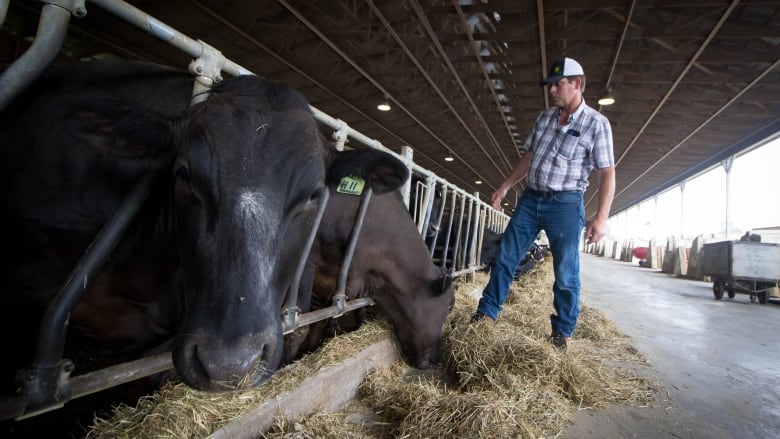How an Ottawa beef farmer ended up raising some of the world’s priciest cattle

For Steven Velthuis, his adventures with purebred Japanese Wagyu beef began a few years ago, on a pricey night out
“I went to a baseball game, a Blue Jays game in Toronto, and I took some colleagues with me,” recalled the Osgoode cattle farmer. “And we went to a restaurant and I said, ‘Anything you want on the menu I’m buying.'”
That was when one friend pointed to an eight-ounce Wagyu steak with sides, Velthuis said — all for a mere $150.
“And I said, ‘Anything but that!'”
Since that fateful meal, Velthuis — who raises dairy and beef cattle on roughly 800 hectares of land in rural south Ottawa — has become one of the few Ontario farmers with a herd of prized Japanese Wagyu, renowned in culinary circles for the marbled texture and rich, decadent mouthfeel of their steaks.
“If you go to the grocery store, you see Wagyu now. There’s just more out there and we’re trying to help our producers with that growth as well“
Specifics are hard to come by, but Velthuis and his son, Brendan, say the number of Wagyu farmers in the province is at most in the low double digits.
And it may not rise sharply any time soon, as Japan declared Wagyu cattle a national treasure in 1997 and no longer exports live animals or their DNA to foreign markets. About five years ago, however, Velthuis went in with a farmer from Quebec on a cow named Naomi whose bloodline can be traced back to Japan, and his entire herd of roughly 50 animals is now made up of her descendants.
Some of the Wagyu beef cattle at Velthuis’ farm. An adult weighs roughly between 630 and 680 kilograms, Velthuis says. (Trevor Pritchard/CBC)
Right now, Velthuis sells mostly through word-of-mouth, with high-end restaurants to sports bars all expressing interest in having something “special on the menu.”
“Just two days ago, a friend of mine was in a town 15 minutes from here, and three-quarters of a pound of rib-steak Wagyu was selling for $80. I do like the numbers, as far as what’s available, as far as selling the meat,” said Velthuis.
“If you like fine wine, if you like good scotch, good cognac, a good cigar — you’re going to love Wagyu beef.”
Velthuis, right, talks about his herd of Wagyu beef cattle on his farm in rural Ottawa as his son Brendan, left, looks on. (Trevor Pritchard/CBC)
DNA registration important
When it comes to the terminology around Japanese beef, it’s worth explaining a few things.
Wagyu, literally “Japanese cow,” refers to the four types of cattle raised for beef production in the country: black, brown, polled and shorthorn. The famed Kobe beef — perhaps the most recognizable Japanese brand — is one particular type of Wagyu, raised to exacting standards in one specific region.
Then there’s American Wagyu, which you might see on a box of burgers in your grocery store’s frozen meat section or, increasingly, at fast food restaurants. It’s a hybrid of Wagyu and other breeds like Angus or Hereford.
There’s also “snow beef,” a cross between Wagyu and Holstein heifers that’s become a niche product in Canada.
Velthuis said his herd is authentic Wagyu, not a cross, and he can prove it: its genetics have been registered with Wagyu associations in both the U.S. and Australia (the Canadian association of Wagyu farmers disbanded a few years ago).
That’s important, he said, in order to give customers the satisfaction that they’re getting the real thing.
The DNA registration process for a full-blood Wagyu herd is “pretty intensive,” said Hanna Ostrovski, director of research, education and programs at the American Wagyu Association.
“We have a pretty sturdy database that verifies those animals. And that’s really important to our producers and to consumers, to kind of understand what they’re buying,” Ostrovski said.
“We all want to make sure that what you pay for is what you get.”
Velthuis plays with one of the young calves at his farm. ‘They’re the friendliest creature out here, for God’s sakes,’ he says. ‘I just love working with them.’ (Trevor Pritchard/CBC)
The popularity of Wagyu has taken off sharply in the past three to five years, said Ostrovski, particularly as more chefs add it to their menus.
“If you go to the grocery store, you see Wagyu now. There’s just more out there. We’re riding that train, we keep on growing, and we’re trying to help our producers with that growth as well.”
Velthuis said his animals are fed a special diet of ground corn and hay and slaughtered at a local abattoir at 30 to 36 months of age, later than other beef cattle, in order to get the full effect of the marbling. All that adds to the higher price point, he said.
As for serving the luscious steaks, Velthuis suggests cooking them medium to medium-rare, with a nice glass of red wine. And if you like your steaks well-done, Wagyu is definitely not for you.
“I’ll tell you — if you’ve got people you want to invite [for dinner], and if you tell them you’re serving Wagyu, chances are they’re going to show up on time.”















